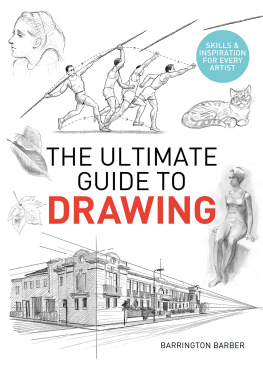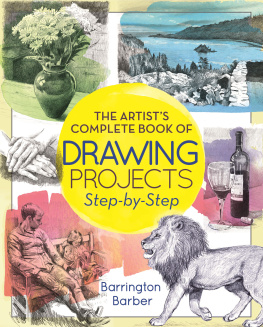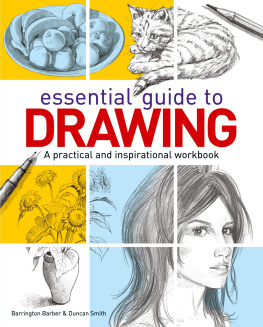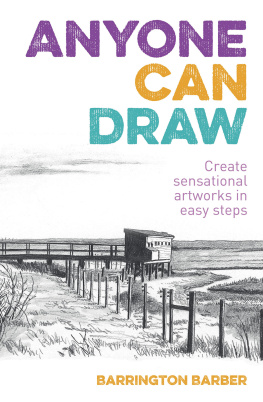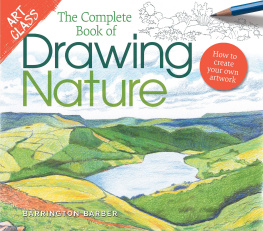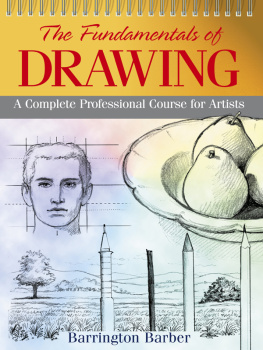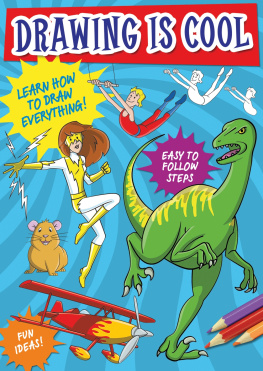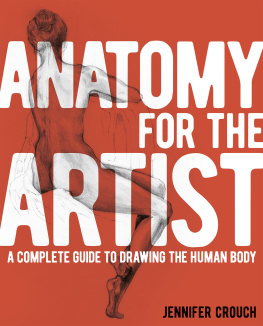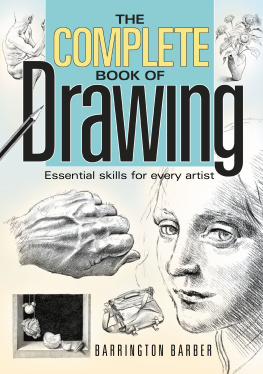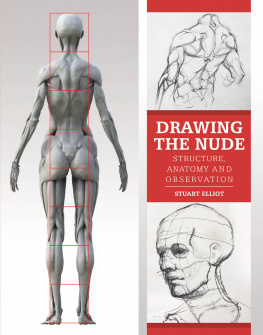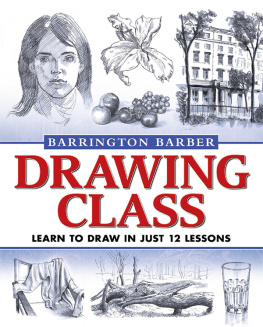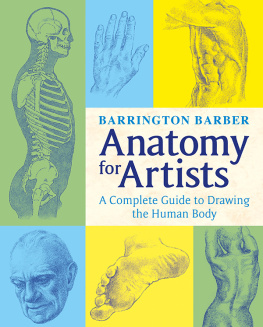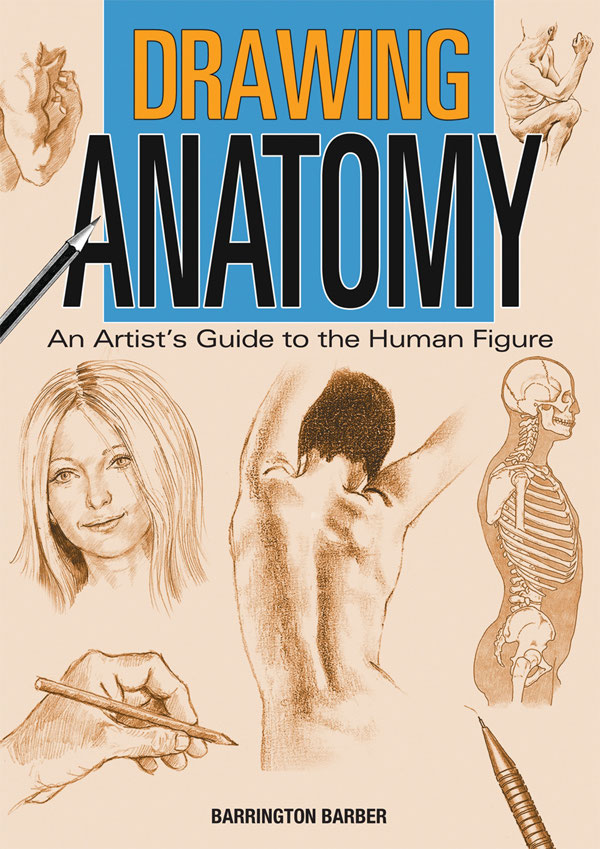DRAWING
ANATOMY
BARRINGTON BARBER
CONTENTS
Introduction
Technical Introduction
The Full Figure
The Head
The Torso
The Arms and Hands
The Legs and Feet
The Head in Movement
The Torso in Movement
The Arms and Hands in Movement
The Legs and Feet in Movement
The Moving Body
Life Drawing
Putting it All Together
Index
INTRODUCTION
Anatomy books are essential for figure artists, but many are published for medical purposes and tend to give too much information for example, the inner organs of the body are interesting to know about, but not relevant for drawing.
What is important for the artist or art student is to learn the structure of the human form, based on the skeleton and the musculature. There have been a number of good and useful books on this subject. Some are a little out of date, not so much in the information that they give but often in the way it has been presented. Other well-produced contemporary books are mainly photographic.
My task has been to produce a comprehensive anatomy book that has all the information necessary for an artist, using drawings and diagrams presented in an easy-to-follow format; and I also wanted to put into it everything that I have found useful in my own drawing practices.
In the first part of this book, I deal with the full figure, followed by a chapter on the anatomy of each major part of the body. Each section shows the skeleton from different viewpoints; then the muscles on top of the bone structure; and finally, the surface form of the human body.
Of course, not all human bodies are perfectly formed and proportions do differ from person to person. Throughout the book I have used well-proportioned, fairly athletic figures. This means that you become acquainted with the shapes of the muscles at their best, although you will probably draw many people who do not have well-toned bodies like these.
In the second part of the book, I examine each part of the body in more detail, concentrating in particular on musculature and how the body moves. Each area of detailed analysis will sometimes repeat what has been shown in the previous chapters: this is necessary because some muscles overlie others, which to a certain extent changes their shape on the surface. So do not be surprised to see the same names cropping up from time to time; it does make them easier to remember, too.
In the technical introduction immediately after this, you will find an explanation of descriptive terms as used in medical circles, followed by a detailed list of Latin terminology. This is worth reading, because understanding anatomical terms will help you to follow the annotations in the book. It may take a little time to memorize all the names you need, but after regular use of these terms you will probably remember enough to describe what you are looking at.
I have omitted any description of the brain, heart, lungs and other viscera because these items are housed within the cranium, the ribcage and the pelvis, and it is the bony parts that dictate the surface shape for figure-drawing purposes. I have also left out details of the male genitalia, because the differences in size and shape are too variable.
Throughout history, artists have looked at our bodies and shown their beauty, power and distortions. I have used the best possible references to draw these pictures, including my own life studies, but have not drawn from dissected corpses as Michelangelo and Leonardo da Vinci did. Artists have contributed much to the study of anatomy, both for artistic and medical purposes. In drawing, the practising artist wants to capture the form of this complex bodily machinery, but first he or she needs to know how it works.
TECHNICAL INTRODUCTION
This section is intended to give you some initial detail about the human anatomy before starting to draw. I have described the properties of bones, muscles, tendons, cartilage, skin, fat and joints, as well as showing diagrams of the different types of joints and muscles. There is also an introduction to anatomical terminology: you will find this useful as certain terms are used throughout the book.
BONES
The skeleton is the solid framework of the body, partly supporting and partly protective. The shape of the skeleton can vary widely. It will affect the build of a person and determine whether they have masses of muscle and fat or not.
Bones are living tissue supplied by blood and nerves. They can become weaker and thinner with lack of use and malnutrition, or heavier and stronger when having to support more weight. They are soft and pliable in the embryo, and only become what we would consider hard and bone-like by the twenty-fifth year of life.
Humans have bones, but a few fuse together with age and it is possible to be born with some bones missing or even having extra ones. We each have a skull, ribcage, pelvis and vertebral column, as well as arm, hand, leg and foot bones. Most bones are symmetrical. The bones of the limbs are cylindrical, thickening towards the ends. The projecting part of a bone is referred to as a process or an eminence.
Highly mobile areas of the body, such as the wrists, consist of numerous small bones. Other bones, like the scapula (shoulder blade) can move in all directions, controlled by the muscles around it.
The bones of the cranium (skull) differ from all others. They grow from separate plates into one fused vault to house the brain. The mandible (jawbone) is the only movable bone in the head.
The long bones of the arms and legs act like levers, while the flat bones of the skull, the cage-like bones of the ribs and the basin shape of the pelvis protect the more vulnerable organs such as the brain, heart, lungs, liver and the abdominal viscera.
MUSCLES
The combination of bones, muscles and tendons allows both strong, broad movements and delicate, precise ones. Muscles perform our actions by contracting or relaxing. There are long muscles on the limbs and broader muscles on the trunk. The more fixed end of the muscle is called the head or and the other end usually farthest from the spine is the The thick muscles are powerful, like the biceps; and the ring-shaped muscles (sphincters) surround the openings of the body, such as the eye, mouth and anus. Certain muscles grow together and have two, three or four heads and insertions. Combined muscles also have parts originating in different places.
The fleshy part of a muscle is called the and the fibrous part the tendon or aponeurosis (see below).
Striated (voluntary) muscles operate under our conscious control. The voluntary muscles account for up to per cent of the bodys weight and form the red flesh. Organized in groups and arranged in several layers, these muscles give the body its familiar form. The following drawings show the various different types of striated muscles, with the tendons at each end. Note the distinctive shape of the sphincter muscle on the far right.
Smooth (involuntary) muscles are confined to the walls of hollow organs, such as intestines and blood vessels. They function beyond our conscious control.


